Siem Reap Itinerary For 3 Days
- By Seema
- Updated July 20, 2025
Siem Reap is bound to appear on your itinerary when deciding what to do in Cambodia. Although you are most likely visiting Siem Reap to see the temples and ruins that the mighty Khmer Empire left behind, there are plenty of other things to do in the city while you are there. Once you’ve had your fill of the ancient temples, you can indulge in Khmer food, shop at lively markets, take a cultural tour of the floating village, and relax with a drink at Pub Street. The gateway to Angkor Wat is particularly popular among digital nomads and backpackers due to its low cost of living and tropical climate. This three-day itinerary for Siem Reap suggests places to see beyond the iconic Angkor Wat and provides ideas for how to make the most of your trip.
Day 1 of Siem Reap Itinerary
Today is our first day in Siem Reap, and we’re going to take it easy. Before you begin exploring the temples of Siem Reap, it is best to educate yourself a little about the history of the country and the Khmer Kingdom. This will give you a better understanding and appreciation for what you will see over the next couple of days. I’ve listed three museums in Siem Reap that you can visit. You can pick your stops based on your interests and the time you arrive in the city. Following lunch, we’ll head to the Floating Village to learn about the local culture and way of life. After the tour, you can stop in the Old City for dinner and spend your evenings browsing the night markets.
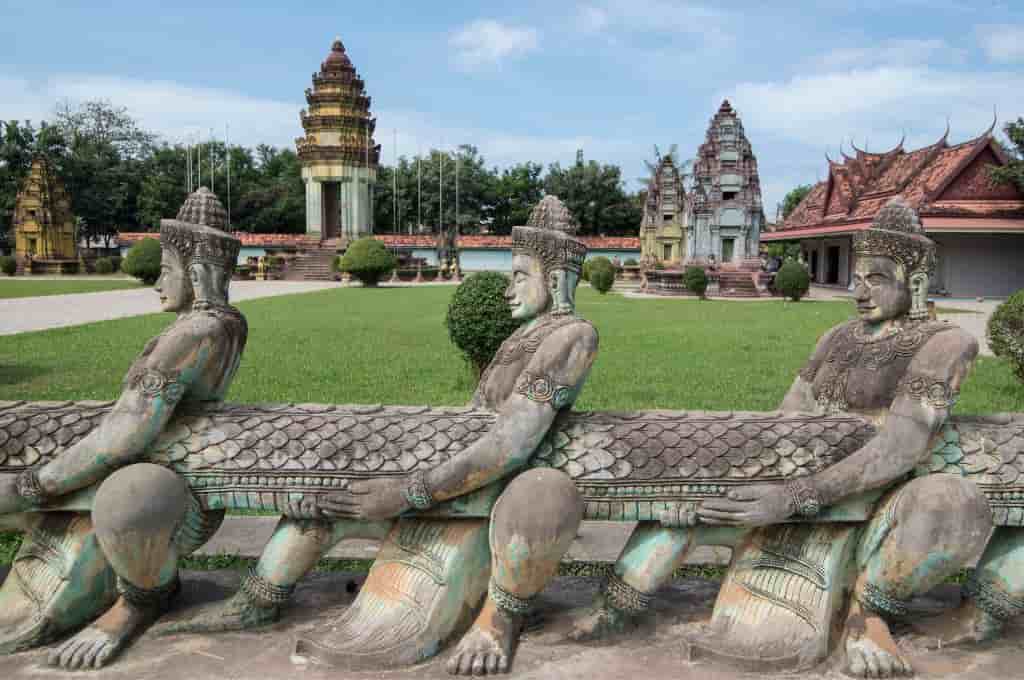
Stop 1: Siem Reap War Museum
The War Museum is situated on the outskirts of the city and can be taken by a tuk-tuk for approximately $2-3. Cambodia has a turbulent past that includes the massacre of innocent Cambodians by the communist Khmer Rouge party. The sole war museum in Cambodia is in Siem Reap. With its impressive collection of artillery guns, jet fighter planes, helicopters, memorabilia, and other machinery, the War Museum transports visitors through the last 30 years of Cambodian war history. The museum’s unique selling point is that it encourages visitors to handle the historic weapons. Soldiers who previously served in the war are now tour guides here.
Ticket Cost – $5
Timings – 8 am – 5:30 pm
Stop 2: Angkor National Museum
The Angkor National Museum is dedicated to the collection, conservation, and learning of Cambodian and Khmer artifacts. Within the expansive museum, eight separate galleries are linked by corridors. Hundreds of Buddhas made of various materials adorn the walls of the first gallery. The other galleries display statues and artifacts discovered at Angkor Wat that shed light on beliefs, religion, and the kings of the Khmer civilization. The Angkor National Museum is situated 1.5 km from the town center and is an excellent venue for learning about the Khmer Empire during the Angkor era.
Ticket Cost – $12
Timings – 8 am – 6 pm
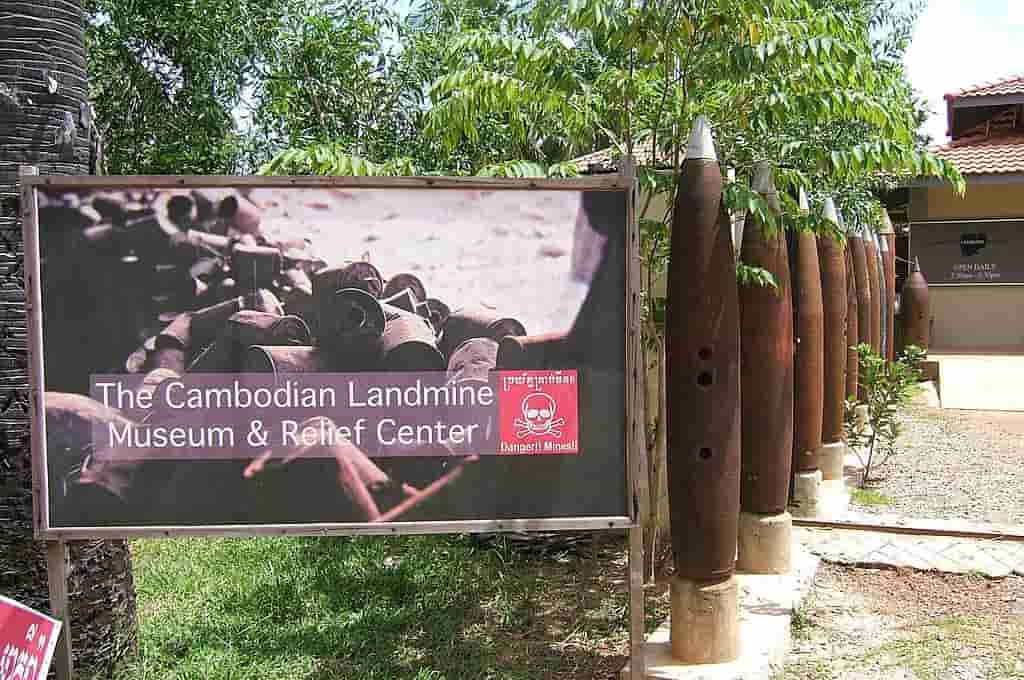
Stop 3: Cambodia Landmine Museum
Gain a fascinating insight into Cambodia’s recent history and the impact of landmines at this informative museum. Cambodia played a critical role in the Vietnam War, and the US dropped extensive amounts of landmines on the country. Cambodia is still dealing with the horrific consequences of a war that took place decades ago. It is estimated that there are 4-6 million unexploded landmines in Cambodia, and new casualties occur often, occasionally harming or killing the locals. The museum founder, Aki Ra, is passionate about clearing landmines and wants to show the world the dangers of war. You will need to take a tuk-tuk to reach the museum, which is approximately 30 minutes away from the town.
Ticket Cost – $5
Timings – 8 am – 5 pm
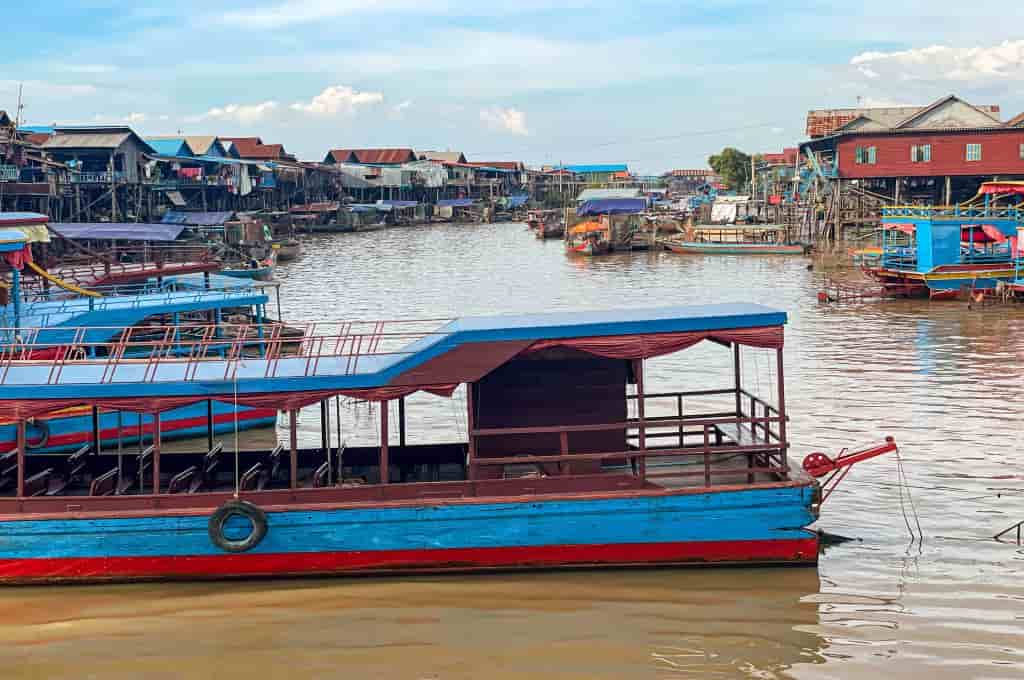
Stop 4: Tonle Sap Lake Tour
After lunch, continue to Tonle Sap Lake. Many floating villages, including the Kompong Phluk, can be found on Asia’s largest freshwater Lake. Situated about a 50-minute drive from Siem Reap, Kompong Phluk is a collection of three floating villages that is home to around 3500 residents. People here live in peculiar high-stilt houses built to withstand significant changes in water levels. During the rainy season, the lakes rise, covering the stilts and creating the illusion that the houses appear to be floating in the water. The tranquil boat ride through the serene waters of Tonle Sap Lake will allow you to experience the daily lives of the local people. The spectacular sunset that marks the end of the cruise is the cherry on top. You might visit these floating villages as part of a half-day tour.
Stop 5: Night Markets
There isn’t just one night market in Siem Reap; there are several night markets located within walking distance of each other. If you’re looking for some art, check out the Siem Reap Art Centre Night Market, which sells vibrant paintings and sculptures. Polish up your haggling skills before visiting the bustling streets. The night market is open daily from 6:00 p.m. to 10:30 p.m.
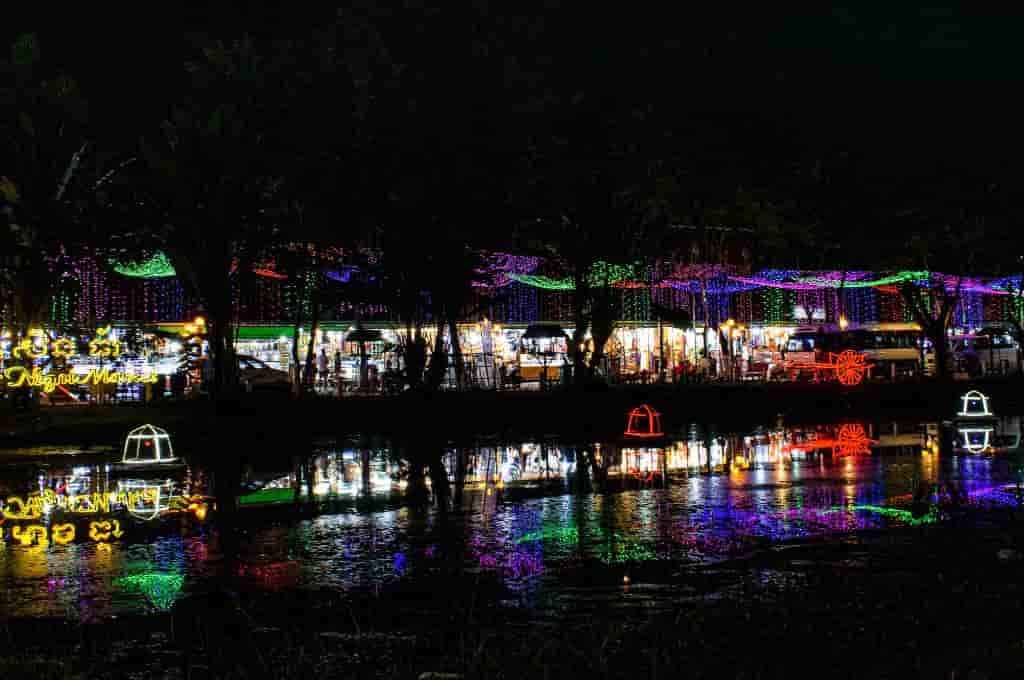
Planning for Angkor Archaeological Park
Angkor Archaeological Park, which covers 400 square km, is an incredible collection of archaeological wonders and ancient temple complexes. Within Angkor Archaeological Park lies an abundance of temples (around 70), each with its distinct charm and historical value. The centerpiece is the world-famous Angkor Wat.
Angkor Archaeological Park is divided into two loops based on the distance between each attraction. The Small Circuit (Le Petit Circuit) encompasses major sites east of Angkor Thom, including Angkor Wat, Ta Prohm, Banteay Kdei, Sras Srang, Ta Keo, and Bayon. The Big Circuit (Le Grand Circuit) encompasses the primary sites in the north and east, including Neak Pean, Ta Som, Pre Rup, and Preah Khan. However, it is not necessary to take the recommended route. You can create your itinerary and select which temples to visit.
The entrance to Angkor Park is only 6 km from the city center, and numerous transportation options are available, including taxis, buses, tuk-tuks, rented motorcycles/bicycles, as well as group/private tours. These locations should ideally be visited with the assistance of a local guide or tour operator. The tours include transfers and transportation, aiming to enhance your sightseeing experience with historical context and convenience. The temples are located far from one another and from the town. Be ready for the heat, wind, and dust if you choose to travel by tuk-tuk.
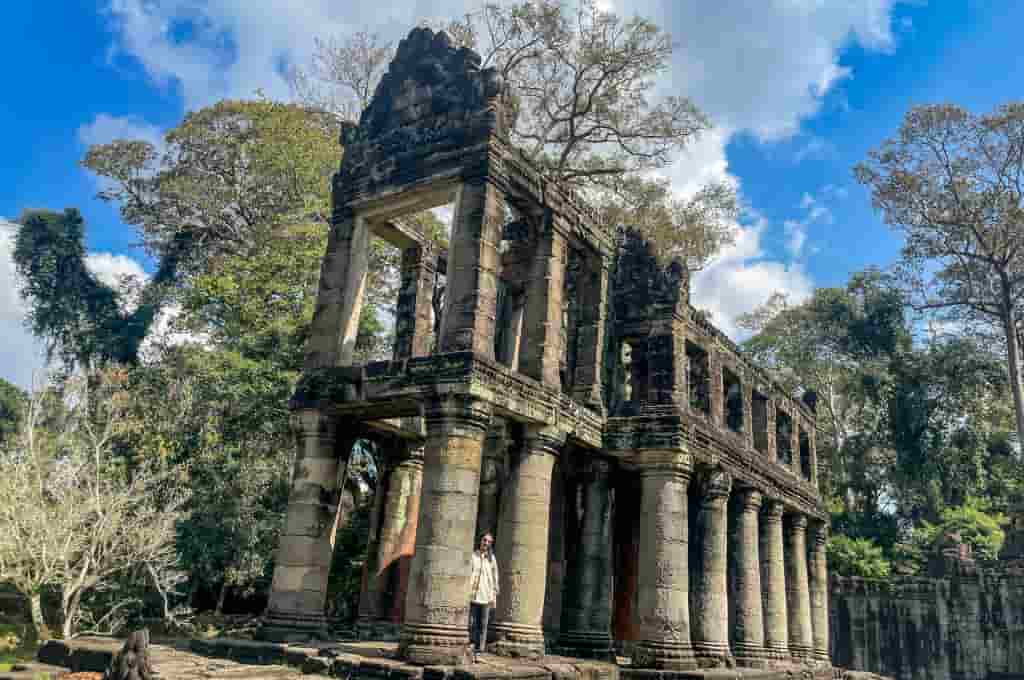
Before our temple tour, we must purchase an Angkor Archaeological Park entrance ticket from the APSARA Office. You’ll need to buy it in person because they’ll take your photo for the pass. The Angkor ticket office opens at 5 a.m. and closes at 7 p.m. You can also purchase the pass online to save time and effort—this Angkor Pass grants access to all temples in the Angkor Archaeological Park. You will need 2 days to explore the temples mentioned below, but since the two-day pass is unavailable, you will have to purchase a three-day pass.
The park complex is open from 5 a.m. to 7 p.m., with most temples closing at 5:30 p.m. The Phnom Bakheng and Pre Rup temples remain open until 7:00 p.m. as they are popular among tourists who want to watch the sunset.
Entrance Fees of Angkor Archaeological Park
Angkor Single-Day Pass – $37.00
Angkor Three-Day Pass – $62.00
Day 2 of Siem Reap Itinerary
While Angkor Wat is the main attraction in Siem Reap, the city is also home to numerous other temples that are just as magnificent and enigmatic. On the second day, get away from the crowds and explore the lesser-known temples of the Angkor Archaeological Park. Grab an early breakfast to fuel yourself for a long, exhausting day, and leave around 7:30 so that you can take advantage of the cooler temperatures. Everyone has their preferences, but we have selected these temples based on convenience and uniqueness. After spending the day exploring the fascinating temples, you should return to the hotel by 4 pm and rest for a while. End the day with an evening performance at Phare, a circus that showcases traditional and contemporary Cambodian performance arts.
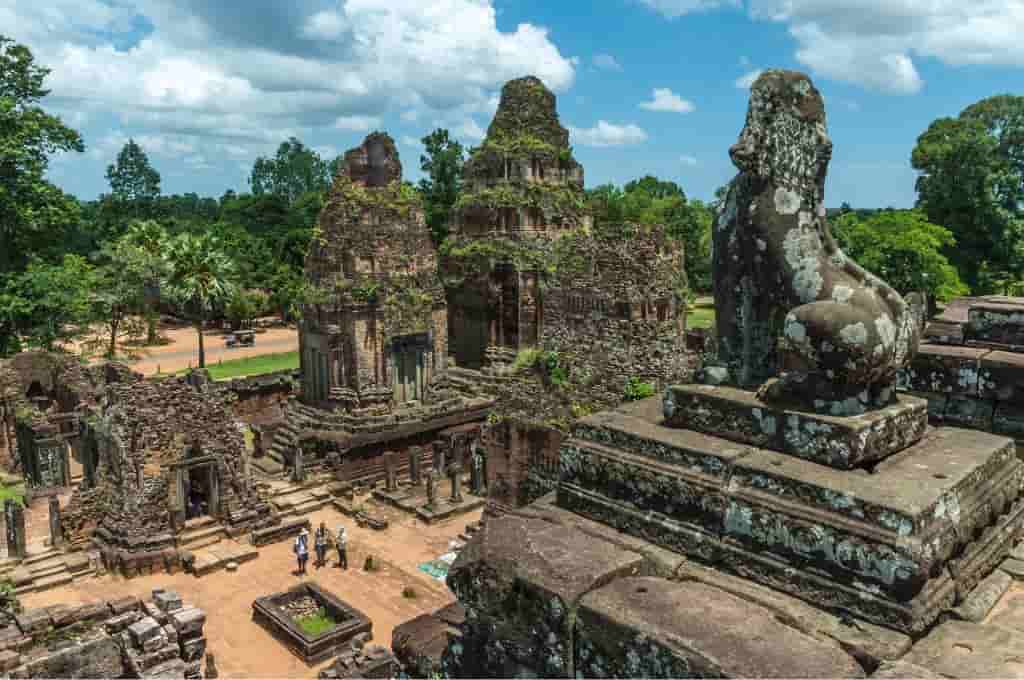
Stop 1: Pre Rup
King Rajendravarman II built Pre-Rup in 961 AD and dedicated it to the Hindu God Shiva. The temple is a pyramid-shaped temple mountain with five lotus towers on its highest tier. You must climb some fairly steep stairs with no handrails to reach the top. Nonetheless, the view from the vantage point is worthwhile, as you can admire the ruins below. Pre Rup is also a popular sunset spot around Angkor due to the stunning view of the surrounding rice fields of the Eastern Baray.
Stop 2: Neak Pean
Neak Pean, or “the entwined snakes,” was constructed by Jayavarman VII in the middle of the 12th century. It is a small temple located on an island in the middle of the now-dry Jayatataka Baray. Gorgeous pink lotuses greet visitors on either side of the pathway as you approach Neak Pean over a lengthy wooden bridge. This central pond is surrounded by four smaller pools representing fire, water, earth, and wind. The tiny temple is dedicated to the Buddhist deity Avalokiteshvara.
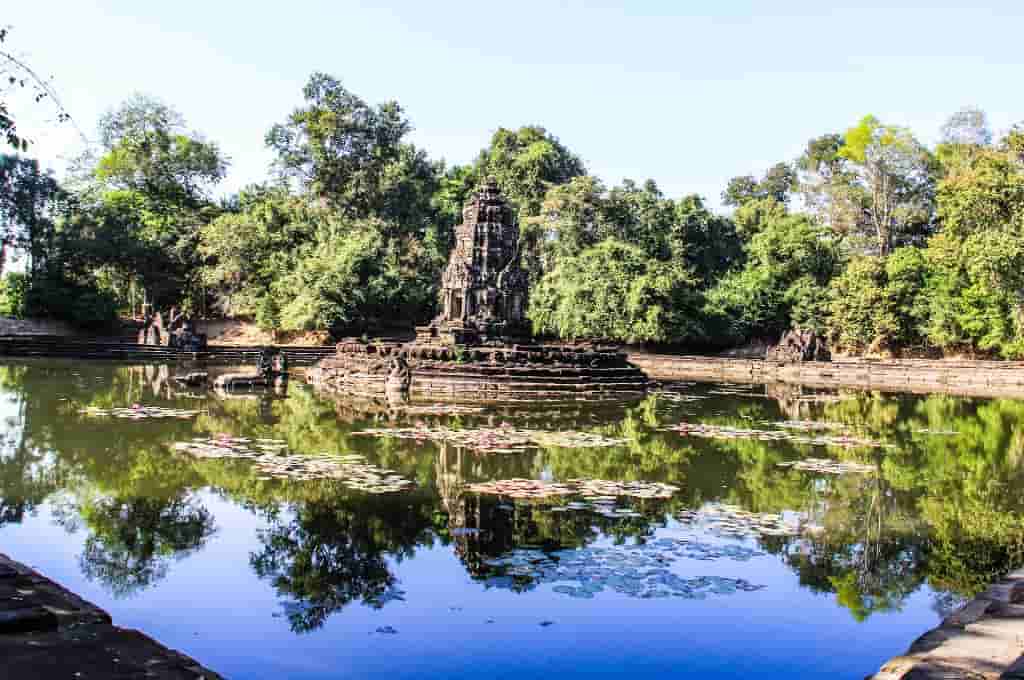
Stop 3: Preah Khan
King Jayavarman VII built the Preah Khan temple in the twelfth century as a memorial to his father. The massive temple occupies more than 130 acres and is located at the northern end of the Angkor Archaeological Park. Preah Khan is a fine representation of a large linear temple complex in a dense jungle setting. The temple is well-preserved and has a maze of corridors, entryways, towers, ceremonial spaces, and galleries that provide excellent photo opportunities.
Stop 4: Banteay Srei
Slightly isolated, Banteay Srei—also called the Citadel of Women—is located 25 km northeast of the main temple complex. It is not part of Angkor Park, but you can visit it with the pass. Believed to have been built in the 10th century, Banteay Srei is one of the most gorgeous temples, with highly decorative and elaborate carvings engraved all over the pink sandstone. The Hindu temple dedicated to Shiva has been wonderfully preserved, and several of its carvings are three-dimensional. The Landmine Museum is also nearby, and if you’re not with a group, you can visit both attractions on the same day.
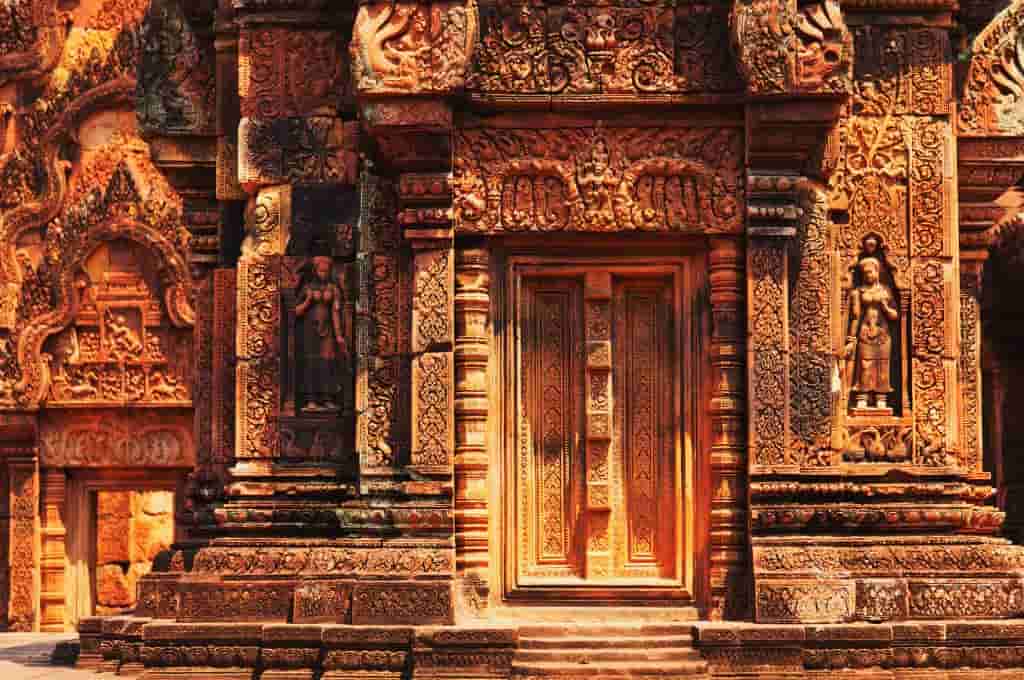
Stop 5: Phare, the Cambodian Circus
Phare Circus is just 2 km away from the Old Market and Pub Street. The one-hour show is run by the NGO Phare Panleu Selpak, which offers children training in a variety of performing arts. Phare Circus showcases Cambodian tales and folk fare through music, dance, acting, and acrobatics. The circus is spectacular, and the energy generated by the performances creates a wonderful atmosphere. In addition to being an impressive and entertaining show, Phare’s social mission makes it a truly worthwhile experience.
Ticket Cost – Starts at $18
Timings – Runs daily at 8 pm
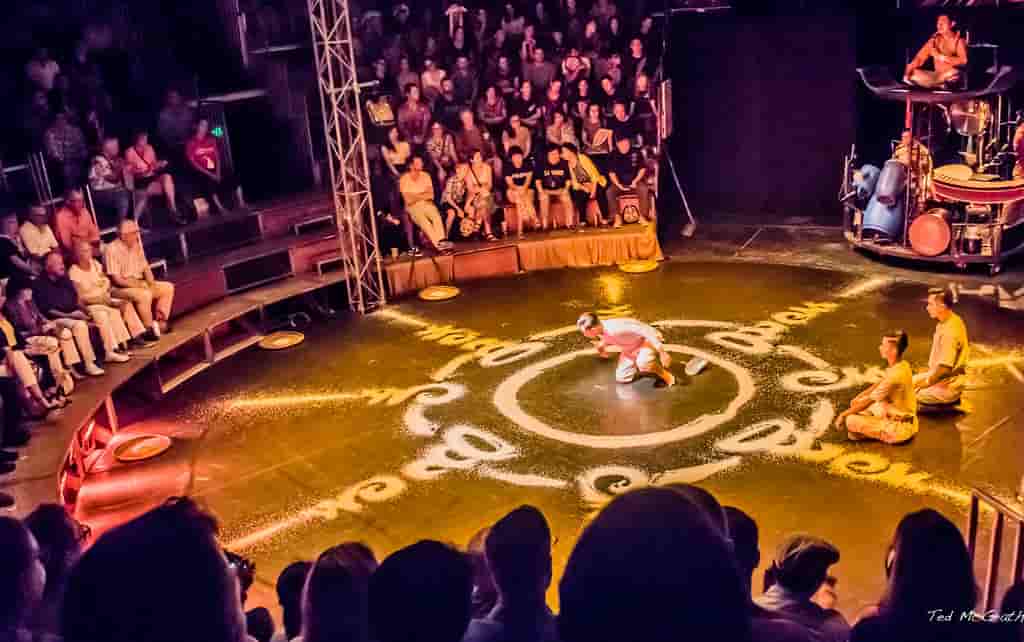
Day 3 of Siem Reap Itinerary
This is the final day in Siem Reap, and we’re going to make the most of it. Leave very early (around 4:30 a.m.) to catch the sunrise over Angkor Wat. Request a boxed breakfast from your hotel—it’s standard procedure there. To get the best viewing spot, you must arrive before 5 a.m. It would be dark, and the path is uneven, so bring a flashlight. To get the “photo,” you’ll have to push your way through the crowd.
After the sun comes up, please make your way to Angkor Wat itself. Visit Ta Prohm and Bayon Temple after you have finished exploring the Angkor Wat complex. Return to your hotel by lunchtime and take an afternoon nap to recuperate from your early morning trip. Head to Phnom Bakheng to see the sunset. Alternatively, take a Tuk-tuk to the Old Market in the late afternoon and browse the shops. Wrap up the day with a visit to Pub Street. Pack your belongings, as you will need to leave Siem Reap the next day.
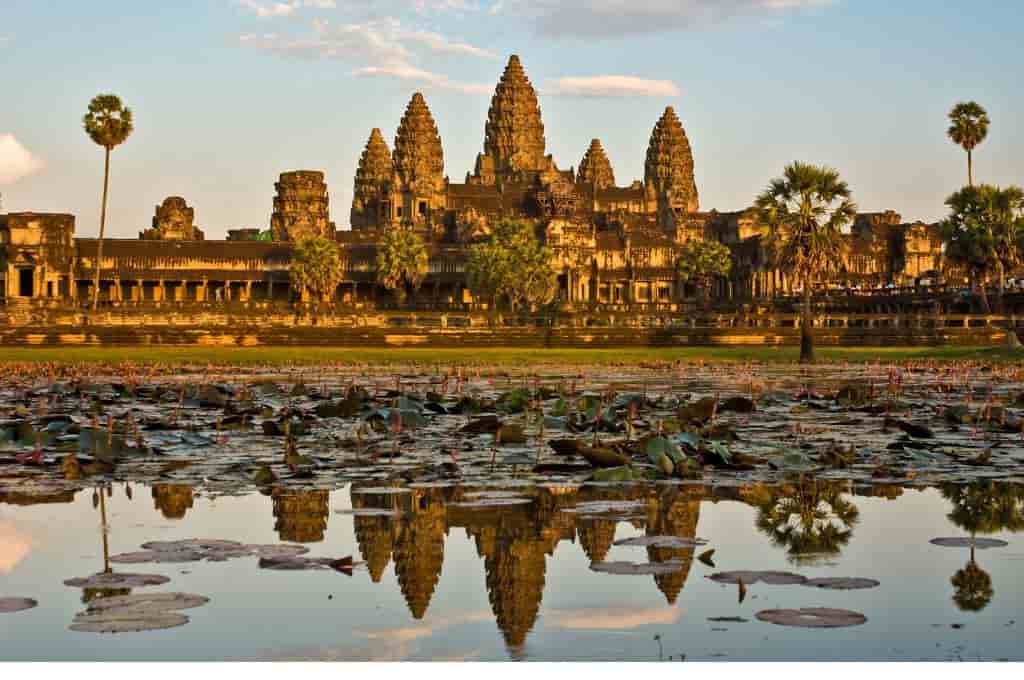
Stop 1: Angkor Wat
Angkor Wat is an architectural masterpiece and one of the finest temples in the world, and it is the main reason tourists visit Siem Reap and Cambodia. The world’s largest religious monument covers 200 acres and was once the capital of the Khmer Empire. The structure is inspired by the sacred Hindu regime and is believed to have taken over thirty years to build. Angkor Wat is the heart and soul of Cambodia and is regarded as the country’s symbol, with its silhouette appearing on the national flag. Almost every inch of this massive complex is covered in intricate carvings and motifs. It is one of the most outstanding monuments in the world, renowned for its perfection in composition, proportions, and sculpture.
The UNESCO World Heritage site attracts 500,000 visitors every year. It is best visited at sunrise to fully appreciate its splendor and capture that iconic image reflected in the pond. Since Angkor Wat is the only temple in the park facing west, it is the only place where you can see the sun rising behind the temple. This magnificent collection of Hindu and Buddhist temples has earned the unofficial title of the World’s Eighth Wonder. This prestigious honor is due to its grandeur, intricate architecture, and historical significance.
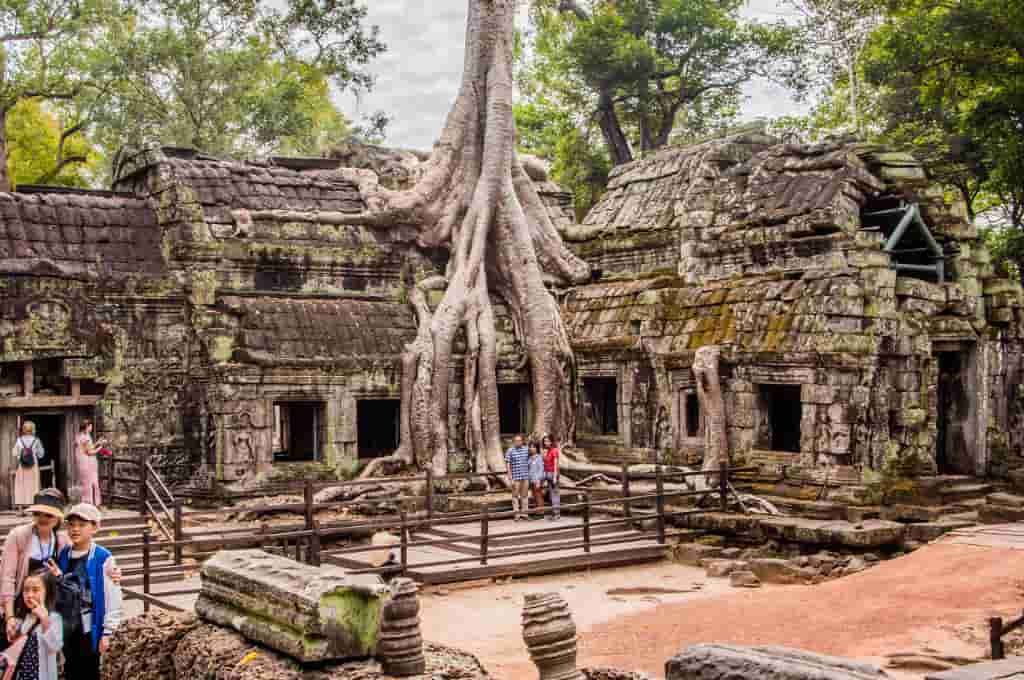
Stop 2: Ta Prohm
Undoubtedly, the most atmospheric ruin at Angkor Park, Ta Prohm, should be at the top of every visitor’s must-see list. Its allure stems from the fact that it is slowly being devoured by the surrounding jungle. The gigantic roots of fig, banyan, and kapok trees have spread over crumbling walls, galleries, and terraces, adding to the mystery and wonder of this amazing site where nature and human creativity merge. Visiting the temple and navigating its narrow corridors, overgrown with moss, lichen, and creeping plants, is an enthralling experience. Ta Prohm has gained prominence over the past few years due to its appearance in the film Lara Croft: Tomb Raider, starring Angelina Jolie.

Stop 3: Bayon Temple
The 12th-century Bayon Temple, built by the Khmer King Jayavarman, sits at the heart of the royal city of Angkor Thom. From afar, the temple appears to be a pile of rubble, but as you get closer, you can appreciate Bayon Temple’s beauty. This temple stands out due to the large, serene faces carved into the towers, which face all four directions. There are 54 Gothic towers within the ruined temples, decorated with over 200 smiling faces of Avalokiteshvara. The faces are exceedingly well preserved and have an intriguing history behind them. From the intricate carvings & enigmatic faces to the towering spires and positive vibes, this temple is a must-see for any traveler, and its unparalleled beauty will leave you in awe. My personal favorite in Siem Reap is the Bayon Temple.
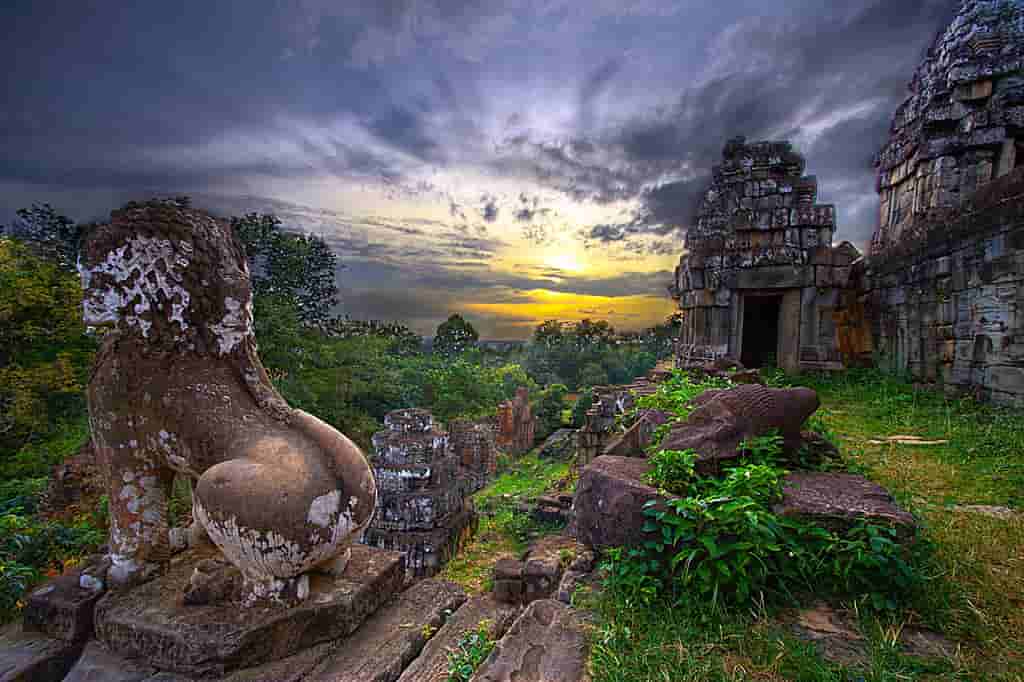
Stop 4: Sunset from Phnom Bakheng
In the early evening, return to the Angkor area to watch the sunset at Phnom Bakheng. The temple is dedicated to Lord Shiva and is a pyramid-shaped temple with seven levels. The temple is located on a hill near Angkor Wat and offers an unobstructed view of the sun as it goes down. Bakheng Temple does not offer a sunset view of Angkor Wat Temple. You get to take in the view of the Angkor Wat area and a distant view of Angkor Wat. To reach the temple, you must walk uphill for 20 minutes. The walk is not difficult, but the Cambodian heat can be exhausting. You can arrive at the temple half an hour before sunset to secure a spot on top. Numbers are now limited to 300 visitors at any given time, so please arrive early.
Stop 5: Shopping & Pub Street
The Old Market is an excellent place to find affordable souvenirs, locally made handicrafts, paintings, jewelry, stone/wood carvings, handcrafted accessories, silk clothing, t-shirts, and gemstones. If you’re looking for authentic and high-quality items made by local artists, visit Artisans d’Angkor and Made in Cambodia Market (check the timing).
After you’ve finished shopping, go to Pub Street, which is right next to the Old Market. It is Siem Reap’s party street and is extremely popular with tourists. Pub Street appears to be a typical street during the day, but it becomes extremely crowded in the evening. It is packed with hipster bars, neon-lit nightclubs, restaurants, massage parlors, market stalls, rolled ice cream stalls, and street food. After a long day of temple tours, this is the place you want to visit for some lively nightlife, Khmer cuisine, and inexpensive drinks. The music gets louder as the night goes on, and the bar spills out onto the street, making for a thrilling night.
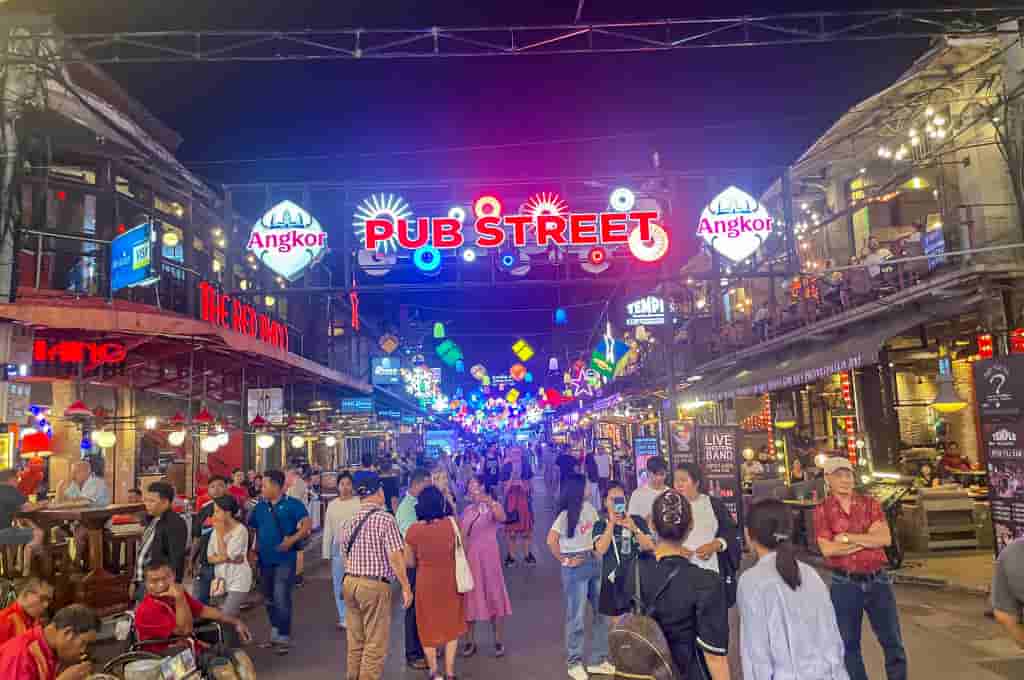
Alternatives
- Other Temples – You can swap the temples mentioned above for some others that you might find interesting.
- Cooking Class – Siem Reap has a wide range of cooking classes to choose from, and they would make an interesting addition to your Siem Reap itinerary. Classes are typically 3-4 hours long and teach you the delicacies of local Khmer cuisine.
- Kulen Waterfall – Take a scenic one-hour drive up Phnom Kulen National Park to explore the River of 1000 Lingas, a Buddhist Pagoda, and some stunning waterfalls. You can also cool off in the shimmering waters of the waterfalls.
- APOPO Rats – Visit the APOPO center to meet the giant rats that are successfully clearing Cambodian territory of landmines
Best Time to Visit Siem Reap?
Cambodia sits in the heart of the tropics, so Siem Reap stays warm all year round. The best time to visit Siem Reap, Cambodia, is between November and February when the weather is cooler and drier. December and January are also peak tourist months, so expect larger crowds, particularly at popular sites like Angkor Wat. To avoid chaos, consider visiting between June and October. Although this time of year falls within the rainy season, you get the chance to view the ancient temples surrounded by lush greenery. Due to the extreme heat, April and May are generally regarded as the least desirable months to visit, with average maximum temperatures reaching 35°C.

How to Get to Siem Reap?
Siem Reap International Airport (REP) was an international airport serving Siem Reap and the Angkor region. It closed in 2023 with the opening of Siem Reap-Angkor International Airport (SAI). The most convenient way to get to Siem Reap is to fly into SAI. There are direct flights from several cities in Southeast Asia to Siem Reap. Flying to Siem Reap from places other than Bangkok and Vietnam would necessitate a stopover in another city before arriving at Siem Reap-Angkor International.
Siem Reap can be reached by bus or taxi from Phnom Penh (6 hours) and other major Cambodian cities. The flight from Phnom Penh to Siem Reap takes approximately 45 minutes. If you’re coming from Thailand, you can cross the border into Cambodia and then take a bus or taxi to Siem Reap. One common entry point is the Poipet-Aranyaprathet border crossing.
How to Get Around in Siem Reap?
It is relatively easy to get around Siem Reap, with several modes of transportation available to explore the city and its surrounding attractions.
- Remorks, also known as Cambodian tuk-tuks, are a popular and inexpensive mode of transportation in Siem Reap. They are essentially carriages attached to motorcycles and can be fun for short trips around the city and temple areas. A short tuk-tuk ride to the city center costs $2-5USD
- Renting a cycle or motorcycle is also an option.
- While traditional taxis are rarely seen in Siem Reap, ride-hailing apps like Grab and PassApp are gaining popularity. They can also be used to hire tuk-tuks.
- For those who prefer air-conditioned transportation or require a vehicle for a larger group, renting a car with a driver is a more comfortable option. Many hotels can arrange car rentals or provide referrals to reputable rental companies.
- The town center of Siem Reap is relatively compact, and walking is an excellent way to explore the markets, restaurants, and local shops. However, for longer distances or trips to the temples, other modes of transportation may be more practical

Things to Know Before Traveling to Siem Reap
- US dollars are preferred and widely accepted in Siem Reap. If you are carrying US dollars, there is no need to exchange them for Cambodian Riels (KHR). Prices in hotels, restaurants, and markets are usually displayed in US dollars. Frequently, you will pay in US dollars and get a change in Riels. Remember that Riel is not a convertible currency outside of Cambodia, so use all of your Riel before leaving the country.
- Credit cards are accepted in hotels and high-end restaurants, but keep small bills on hand for small eateries, tuk-tuks, and market shopping
- If you are purchasing a one-day Angkor Pass, get it after 5 p.m. the day before your desired temple visit. Tickets purchased after 5 p.m. can be used on the same day and the following day. This way, you can visit the temples to enjoy the sunset and then return the next day to use the pass for the entire day.
- Take care of your Angkor Pass. It will be required every time you enter a temple. You will have to replace it if you lose it.
- Although Siem Reap is a relatively safe city, be wary of pick-pockets, especially while walking or riding in a tuk-tuk. They’ll pass by on a motorbike and snatch your phone or handbag.
- Shoulders and knees must be covered at all times when visiting the temples.
- Bring plenty of water and a generous amount of sunscreen, as it can get extremely hot and you will be walking in the scorching sun. It’s always helpful to have an umbrella or a hat.
- You will be walking a lot and climbing steep stairs while visiting temples, so wear appropriate footwear.
- Take insect repellent with you. You’ll need it, especially when you’re waiting for the sunrise in front of the Angkor Wat pond. It is best to wear trousers at that time to keep insects at bay
- Tap water is unsafe in Cambodia, so always drink bottled water.
- The locals understand basic English, and you will have no trouble communicating with them.
